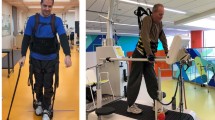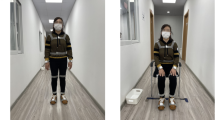Abstract
Study design:
This is a retrospective study.
Objectives:
The objectives of this study were to categorize unexpected postural changes (UPCs) during gait training in paraplegic patients with wearable gait-assist robots, to reveal the incidence of the UPC and its time-dependent changes during initial gait training period and to investigate neurological level-specific differences.
Setting:
This study was conducted in Fujita Health University, Aichi, Japan.
Methods:
We investigated five patients (46.2±14.6 years; lesion level: T6:3, T12:2). All patients had previously achieved gait with wearable robot and walker at supervision level. The UPCs were counted for 2 years and classified according to their type. The time-course data were calculated from the incidence of UPCs for 10 days from initial gait training with the walker. The neurological level-specific differences were investigated between T6 and T12 injuries.
Results:
Eighty-five UPCs were observed and classified into three categories: anterior breakdown, posterior breakdown (PBD) and mal-timing. The average rate over the entire period was 0.96±0.62 (incidents/h/subject). PBD, which was defined as hyperflexion of both hip joints, occurred with the highest frequency (0.64±0.64 incidents/h/subject). During initial gait training, there was a gradual decrease in the occurrence of UPC. For neurological level-specific differences, UPCs were observed more frequently in T6 injuries (1.36±0.35 incidents/h/subject) compared with T12 injuries (0.36±0.31 incidents/h/subject).
Conclusion:
PBDs might be the result of near collisions between the trunk of the user and the walker, which make it difficult for the users to move their trunk over an anterior stance limb. Training that is focused upon well-timed forward movements of the walker might be required to avoid the occurrence of this common UPC.
Similar content being viewed by others
Log in or create a free account to read this content
Gain free access to this article, as well as selected content from this journal and more on nature.com
or
References
Maynard FM Jr, Bracken MB, Creasey G, Ditunno JF Jr, Donovan WH, Ducker TB et al. International standards for neurological and functional classification of spinal cord injury. American Spinal Injury Association. Spinal Cord 1997; 35: 266–274.
Harvey LA, Adams R, Chu J, Batty J, Barratt DA . Comparison of patients’ and physiotherapists’ expectations about walking post spinal cord injury: a longitudinal cohort study. Spinal Cord 2012; 50: 548–552.
Morganti B, Scivoletto G, Ditunno P, Ditunno JF, Molinari M . Walking index for spinal cord injury (WISCI): criterion validation. Spinal Cord 2005; 43: 27–33.
Battaglino RA, Lazzari AA, Garshick E, Morse LR . Spinal cord injury-induced osteoporosis: pathogenesis and emerging therapies. Curr Osteoporos Rep 2012; 10: 278–285.
Dijkers MP . Correlates of life satisfaction among persons with spinal cord injury. Arch Phys Med Rehabil 1999; 80: 867–876.
Fuhrer MJ, Rintala DH, Hart KA, Clearman R, Young ME . Relationship of life satisfaction to impairment, disability, and handicap among persons with spinal cord injury living in the community. Arch Phys Med Rehabil 1992; 73: 552–557.
Major RE, Stallard J, Rose GK . The dynamics of walking using the hip guidance orthosis (hgo) with crutches. Prosthet Orthot Int 1981; 5: 19–22.
Saitoh E, Suzuki T, Sonoda S, Fujitani J, Tomita Y, Chino N . Clinical experience with a new hip-knee-ankle-foot orthotic system using a medial single hip joint for paraplegic standing and walking. Am J Phys Med Rehabil 1996; 75: 198–203.
Arazpour M, Bani MA, Hutchins SW, Jones RK . The physiological cost index of walking with mechanical and powered gait orthosis in patients with spinal cord injury. Spinal Cord 2013; 51: 356–359.
Tanabe S, Hirano S, Saitoh E . Wearable Power-Assist Locomotor (WPAL) for supporting upright walking in persons with paraplegia. NeuroRehabilitation 2013; 33: 99–106.
Tanabe S, Saitoh E, Hirano S, Katoh M, Takemitsu T, Uno A et al. Design of the Wearable Power-Assist Locomotor (WPAL) for paraplegic gait reconstruction. Disabil Rehabil Assist Technol 2013; 8: 84–91.
Nankaku M, Kanzaki H, Tsuboyama T, Nakamura T . Evaluation of hip fracture risk in relation to fall direction. Osteoporos Int 2005; 16: 1315–1320.
Dudley-Javoroski S, Shields RK . Dose estimation and surveillance of mechanical loading interventions for bone loss after spinal cord injury. Phys Ther 2008; 88: 387–396.
Reinkensmeyer DJ, Aoyagi D, Emken JL, Galvez JA, Ichinose W, Kerdanyan G et al. Tools for understanding and optimizing robotic gait training. J Rehabil Res Dev 2006; 43: 657–670.
Sze KH, Wong E, Leung HY, Woo J . Falls among Chinese stroke patients during rehabilitation. Arch Phys Med Rehabil 2001; 82: 1219–1225.
Nyberg L, Gustafson Y . Patient falls in stroke rehabilitation. A challenge to rehabilitation strategies. Stroke 1995; 26: 838–842.
Tutuarima JA, van der Meulen JH, de Haan RJ, van Straten A, Limburg M . Risk factors for falls of hospitalized stroke patients. Stroke 1997; 28: 297–301.
Tate JJ, Milner CE . Real-time kinematic, temporospatial, and kinetic biofeedback during gait retraining in patients: a systematic review. Phys Ther 2010; 90: 1123–1134.
Lajoie Y, Teasdale N, Bard C, Fleury M . Attentional demands for static and dynamic equilibrium. Exp Brain Res 1993; 97: 139–144.
Lajoie Y, Barbeau H, Hamelin M . Attentional requirements of walking in spinal cord injured patients compared to normal subjects. Spinal Cord 1999; 37: 245–250.
Lin KH, Lu TW, Hsu PP, Yu SM, Liao WS . Postural responses during falling with rapid reach-and-grasp balance reaction in patients with motor complete paraplegia. Spinal Cord 2008; 46: 204–209.
Zeilig G, Weingarden H, Zwecker M, Dudkiewicz I, Bloch A, Esquenazi A . Safety and tolerance of the ReWalk™ exoskeleton suit for ambulation by people with complete spinal cord injury: A pilot study. J Spinal Cord Med 2012; 35: 96–101.
Esquenazi A, Talaty M, Packel A, Saulino M . The ReWalk powered exoskeleton to restore ambulatory function to individuals with thoracic-level motor-complete spinal cord injury. Am J Phys Med Rehabil 2012; 91: 911–921.
Spungen AM, Asselin P, Fineberg DB, Kornfeld SD, Harel NY . Exoskeletal-assisted walking for persons with motor-complete paraplegia. Research and Technology Organization, Human Factors, and Medicine Panel: North Atlantic Treaty Organization 2013 Available from: http://www.cso.nato.int.
Galvez JA, Reinkensmeyer DJ . Robotics for gait training after spinal cord injury. Top Spinal Cord Inj Rehabil 2005; 11: 18–33.
Acknowledgements
Our heartfelt appreciation goes to the late Professor Toru Suzuki who provided helpful advice on experimental design and suggestions on the interpretation of present results. We thank also Hagemu Higuchi and Kiyokazu Nakamura for their helpful data collection and technical assistance. We also thank all subjects for participating in the study. This work is financially supported by the NEDO grant for Basic Technology Development for Practical Application of Human Support Robots (8068149) and Practical Development of Industrial Technology (8080694), and fund from Aichi Science and Technology Foundation (22–2).
Author information
Authors and Affiliations
Corresponding author
Ethics declarations
Competing interests
TT is a salaried employee of the ASKA Corporation, which produces WPAL. AU is a salaried employee of the Tomei Brace Company, which distributes WPAL. The remaining authors declare no conflict of interest.
Rights and permissions
About this article
Cite this article
Koyama, S., Tanabe, S., Saitoh, E. et al. Characterization of unexpected postural changes during robot-assisted gait training in paraplegic patients. Spinal Cord 54, 120–125 (2016). https://doi.org/10.1038/sc.2015.138
Received:
Revised:
Accepted:
Published:
Issue date:
DOI: https://doi.org/10.1038/sc.2015.138
This article is cited by
-
Superposition principle applies to human walking with two simultaneous interventions
Scientific Reports (2021)



